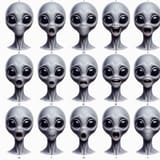A hypothetical alien species with three fingers per limb would likely develop a number system and mathematical framework influenced by their physical anatomy, much like humans developed base-10 (decimal) systems due to having ten fingers. Below, I explore how their mathematics and number systems might look, considering their three-fingered limbs, and provide a concise yet comprehensive analysis.Number System: Base-3 (Ternary)Base Choice: With three fingers per limb, the aliens would naturally gravitate toward a base-3 (ternary) number system, as it aligns with their ability to count using their fingers. Each hand (or limb) could represent one digit in base-3, with values 0, 1, and 2.
Counting Mechanism: They might count by assigning each finger a state (e.g., down for 0, half-raised for 1, fully raised for 2). For example:0: all fingers down.
1: one finger half-raised.
2: one finger fully raised.
3: start over with the next limb or a new counting gesture (e.g., two fingers half-raised or a second limb’s finger raised).
Representation: Numbers in base-3 use digits {0, 1, 2}. For example:The number 3 in base-10 is 10 in base-3 (1 × 31 + 0 × 30 = 3).
The number 4 in base-10 is 11 in base-3 (1 × 31 + 1 × 30 = 4).
The number 9 in base-10 is 100 in base-3 (1 × 32 + 0 × 31 + 0 × 30 = 9).
Multiple Limbs: If they have multiple limbs (e.g., two limbs with three fingers each), they might count up to 32 = 9 (base-10) using both limbs before needing additional notation, similar to how humans use two hands to count to 10.
